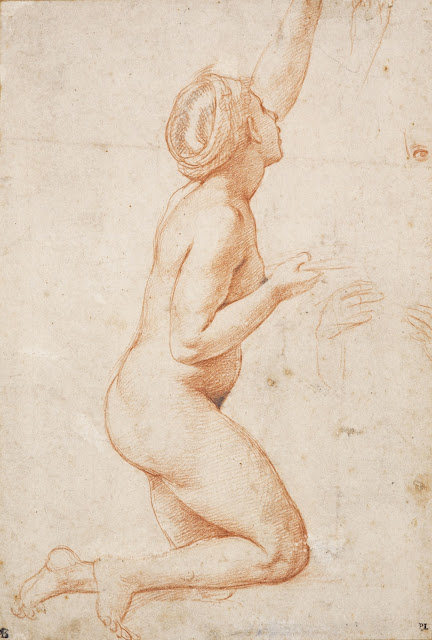 |
| Filippino Lippi Studies of a kneeling and a seated youth before 1504 drawing National Galleries of Scotland |
 |
| Raphael Study for the painting Madonna del pesce ca. 1512-14 drawing National Galleries of Scotland |
 |
| Raphael Kneeling woman with arm raised ca. 1518 drawing National Galleries of Scotland |
 |
| Parmigianino Madonna and Child ca. 1520-30 drawing National Galleries of Scotland |
 |
| attributed to Fra Bartolomeo Studies from a lay figure (mannequin) before 1517 drawing Fitzwilliam Museum, Cambridge |
"The articulated human figure was a common tool in artistic practice in Europe from at least the fifteenth century. Its indefatigable limbs and silent compliance allowed the artist to explore the structure of a composition in three-dimensional form, and to 'rehearse' a range of pictorial effects – not least the arrangement of drapery or clothing – before committing to the finished state. Throughout the centuries that followed, the mannequin became an invaluable artistic ally, recommended, with varying degrees of approbation and reservation, by generations of artists and theoreticians, some of whom devised especially ingenious uses for these 'machines'."
– Jane Munro, from Silent Partners: Artist and Mannequin from Function to Fetish (Fitzwilliam Museum and Yale University Press, 2014)
 |
| attributed to Fra Bartolomeo Study from a lay figure (mannequin) before 1517 drawing Fitzwilliam Museum, Cambridge |
 |
| circle of Fra Bartolomeo Drapery study for kneeling Apostle before 1517 drawing Fitzwilliam Museum, Cambridge |
 |
| Fra Bartolomeo Drapery study of standing man before 1517 drawing Fitzwilliam Museum, Cambridge |
 |
| Domenico Beccafumi Portrait head of a lady in profile before 1551 drawing National Galleries of Scotland |
 |
| Domenico Beccafumi Sheet of studies before 1551 drawing Fitzwilliam Museum, Cambridge |
 |
| Domenico Beccafumi Seated man and two decapitated heads before 1551 drawing Fitzwilliam Museum, Cambridge |
 |
| attributed to Domenico Beccafumi St Mary Magdalene before 1551 drawing Fitzwilliam Museum, Cambridge |
 |
| Battista Franco Baptism of Christ with St Bernardino of Siena and St Francis 1552-54 drawing National Galleries of Scotland |
 |
| Battista Franco God the Father 1552-54 drawing National Galleries of Scotland |
God
In his malodorous brain what slugs and mire,
Lanthorned in his oblique eyes, guttering burned!
His body lodged a rat where men nursed souls.
The world flashed grape-green eyes of a foiled cat
To him. On fragments of an old shrunk power,
On shy and maimed, on women wrung awry,
He lay, a bullying hulk, to crush them more.
But when one, fearless, turned and clawed like bronze,
Cringing was easy to blunt these stern paws,
And he would weigh the heavier on those after.
Who rests in God's mean flattery now? Your wealth
Is but his cunning to make death more hard.
Your iron sinews take more pain in breaking.
And he has made the market for your beauty
Too poor to buy, although you die to sell.
Only that he has never heard of sleep;
And when the cats come out the rats are sly.
Here we are safe till he slinks in at dawn.
But he has gnawed a fibre from strange roots,
And in the morning some pale wonder ceases.
Things are not strange and strange things are forgetful.
Ah! if the day were arid, somehow lost
Out of us, but it is as hair of us,
And only in the hush no wind stirs it.
And in the light vague trouble lifts and breathes,
And restlessness still shadows the lost ways.
The fingers shut on voices that pass through,
Where blind farewells are taken easily . . .
Ah! this miasma of a rotting God!
– Isaac Rosenberg (1890-1918)